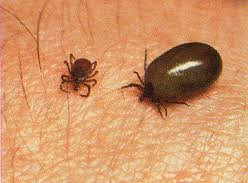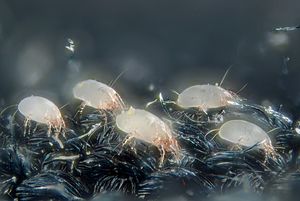General Information on Ticks & Mites
Blacklegged Tick or Deer Tick
 The blacklegged tick or Deer Tick, Ixodes scapularis, is an integral feature in the transmission dynamics of Lyme disease. Human exposure to these type of ticks is higher during summer when ticks and human outdoor activity are greater. Their bites are usually painless, and people often do not feel something until the symptoms appear. Hikers and campers should always check themselves or use protection during their activity. The females usually feed for extended periods and you can find them attached to your skin.
The blacklegged tick or Deer Tick, Ixodes scapularis, is an integral feature in the transmission dynamics of Lyme disease. Human exposure to these type of ticks is higher during summer when ticks and human outdoor activity are greater. Their bites are usually painless, and people often do not feel something until the symptoms appear. Hikers and campers should always check themselves or use protection during their activity. The females usually feed for extended periods and you can find them attached to your skin.
Named for their habit to feed on white-tailed deer, these kind of ticks also feed on other large hosts such as us. Humans are just considered accidental hosts and may spread Lyme disease from bites. Domestic animals and Livestock can also be hosts. They are present throughout the eastern part of the United States and tend to live along trails and in wooded areas in forests.
Household Dust Mites
 A house dust mites are too small for a naked eye. Under a microscope, dust mites resembles a white bugs. These mites usually have eight legs, but they are not insects, they are from the family of arthropods – like spiders. If you or any of your family members have asthma or allergies, a tiny living creature in your house can definitely bring big problems. Although you can’t see these dust mites with your eyes, it may bring an allergic reaction to you and your family.
A house dust mites are too small for a naked eye. Under a microscope, dust mites resembles a white bugs. These mites usually have eight legs, but they are not insects, they are from the family of arthropods – like spiders. If you or any of your family members have asthma or allergies, a tiny living creature in your house can definitely bring big problems. Although you can’t see these dust mites with your eyes, it may bring an allergic reaction to you and your family.
Dust mites may be one of the most typical reason of year-round asthma and allergies. These small creatures are found on every corner of the world except Antarctica. It is not impossible to get rid of these creatures entirely. Dust mites can be found on mattresses, carpets, upholstered furniture, bedding, and curtains. They feed on the flakes of skin that people shed everyday and they thrive in humid environments.
